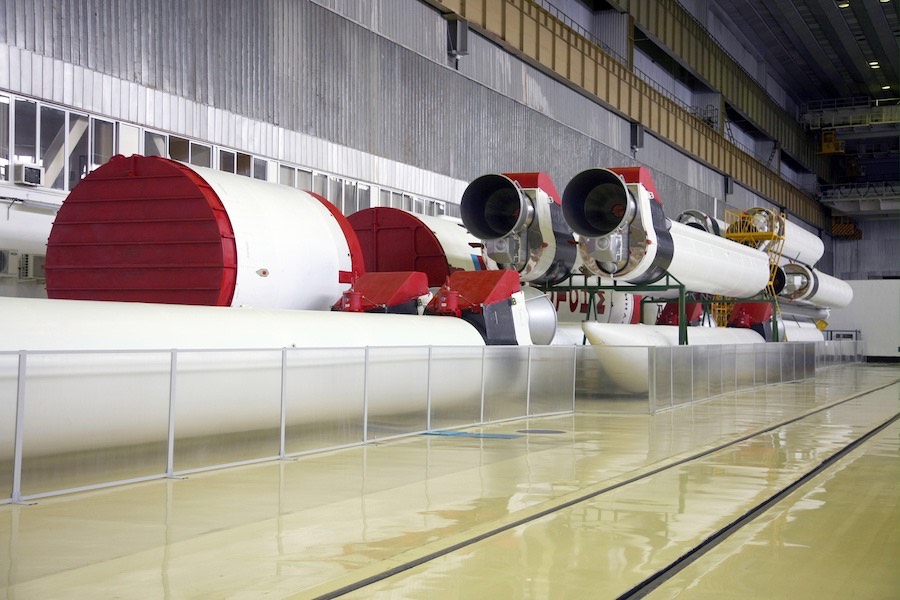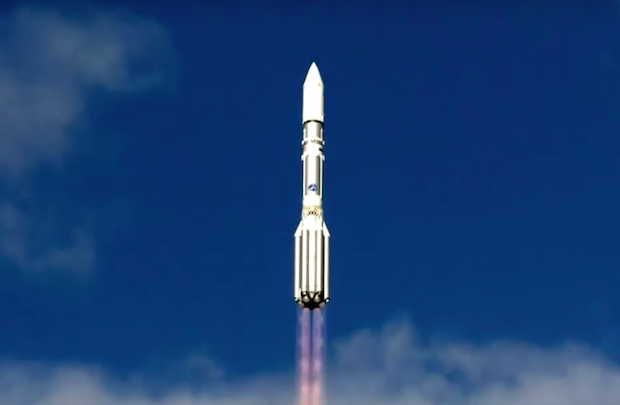
International Launch Services, facing headwinds in a commercial launch market now largely shaped by billionaires and satellite miniaturization, has touted a new relationship with the Russian space agency and Glavkosmos as a means to drive down Proton rocket prices, make Russian space industry more friendly to the commercial market, and diversify its offerings.
U.S.-based ILS announced a change in its governance in April, with Glavkosmos — an enterprise owned by the Russian government — taking control from Khrunichev, the Russian manufacturer of the Proton rocket.
Glavkosmos is a daughter company of Roscosmos, the Russian space agency, charged with marketing Russian space industry products and services on the global market. Khrunichev remains the majority owner of ILS, but Glavkosmos now controls the company after taking two seats on the company’s board of directors from Khrunichev, according to Kirk Pysher, president of ILS.
ILS is responsible for commercial sales of the Proton rocket, a heavy-lifter built near Moscow and launched from the Baikonur Cosmodrome in Kazakhstan. The new governance scheme gives ILS a cozier relationship with Roscosmos.
In a press briefing last week at the Satellite 2019 conference in Washington, D.C., Pysher said the change “gives us access to Roscosmos for talking strategy, pricing, schedules, etc.
“We believe that this now helps us create a new set of products, set of processes, that will allow us to compete more effectively,” Pysher said.
The Russian government plans to use the Proton rocket through the mid-2020s, and the Proton will only be retired when the replacement Angara rocket enters operational service.
“It is a tight market,” Pysher said. “We’re competing against a couple of billionaires,” he said, referring to Elon Musk’s SpaceX and Jeff Bezos’s Blue Origin.
“It’s a difficult market, but the reality is Proton isn’t going to go away. It’s still going to be there flying, so let’s see if we can try to make some money from it on a commercial basis.”

Headquartered in a suburb of Washington, ILS has seen its place in the global commercial launch market eroding in recent years as SpaceX achieved a cadence of launches with its Falcon 9 rocket, while orders for large communications satellites once tailored for the Proton launcher took a nosedive.
Meanwhile, the Proton rocket suffered several failures and off-target payload deployments, raising reliability concerns among commercial satellite operators.
Entrenched communications satellite operators, with fleets of bus-sized spaceraft in geostationary orbit more than 22,000 miles (nearly 36,000 kilometers), have long been core customers for ILS.
But fewer of those satellites — designed for television broadcasting, data networking and broadband services — are being ordered, as existing operators and new entrants — such as SpaceX, OneWeb and Telesat — begin work on constellations of hundreds or thousands of smaller spacecraft to beam Internet signals from space.
The most recent ILS mission was in September 2017, and the company has conducted just five commercial Proton launches since the end of 2015. ILS is also charged with marketing flights using Russia’s new Angara launcher, which has a light-class variant designed for launches into low Earth orbit, and a bigger heavy-lift version that will eventually replace the Proton in the mid-2020s.
With Glavkosmos now in control of ILS, Pysher said commercial space interests will have a stronger voice with Roscosmos. It helps that Dmitry Loskutov, director general of Glavkosmos, was an aide to Roscosmos chief Dmitry Rogozin for more than a decade, when Rogozin served as an envoy to NATO and as a Russian deputy prime minister.
“Since I’ve been working with Mr. Rogozin more than 10 years already, we have that direct channel to the director general of Roscosmos,” Loskutov said during the May 7 press briefing in Washington.
Rogozin is a controversial figure who was one of numerous Russian government figures sanctioned by the U.S. government in the wake of Russia’s annexation of Crimea in 2014. Pysher said ILS has experienced no impact from the Russian sanctions.
“It’s a complex issue sometimes,” Loskutov said of Russian efforts to gain a bigger foothold in the global commercial space marketplace. “Khrunichev alone cannot solve this issue. We need a complex effort here, and that’s why we have to go to the government directly and propose some measures from Roscosmos.”

“Before, we were working almost exclusively with Khrunichev, and that exclusive relationship was basically Proton and maximizing Khrunichev’s profitability,” Pysher said. “So now we have the ability to coordinate across the board.
A subsidiary of Glavkosmos named GK Launch Services sells Soyuz rocket flights on the commercial market. Under the management of Glavkosmos, ILS and GK Launch Services will offer Soyuz and Proton missions in parallel, with ILS taking a leading role in sales in the North American market, Pysher said.
GK Launch Services has had more recent success than ILS in attracting commercial customers. While the Proton rocket has primarily launched large satellites toward geostationary orbit one-at-a-time, the Soyuz can accommodate clusters of smaller payloads heading to lower orbits a few hundred miles above Earth.
One of Glavkosmos’s biggest contracts in the international launch business involves coordinating the production, export and launch support services for 21 Soyuz missions dedicated to OneWeb’s broadband constellation. OneWeb booked its launches with the French company Arianespace, but the Soyuz rockets are built in Russia.
GK Launch Services arranged the launch in December of 15 small commercial satellites from U.S., German and Japanese operators on a single Soyuz rocket from the Vostochny Cosmodrome in Russia’s Far East. The payloads under contract to GK Launch Services rode into space with 13 other spacecraft on the Soyuz rocket.
The next mission planned by GK Launch Services will involve dozens of small commercial payloads riding piggyback on a Soyuz rocket this summer with a Russian weather satellite.
“So now what we can do, or the vision that we have going forward, is that we will essentially be cross-marketing those products,” Pysher said. “So we’ll be marketing Soyuz and GK Launch will be marketing Proton and Angara, and as the new product lines come out, we’ll be sharing the marketing rights there as well.
“It will probably be based on geography as to where we market products, but it also allows us to then package solutions for our customers,” Pysher said.
Through its new relationship with Glavkosmos and Roscosmos, ILS could play a bigger role in selling other Russian spaceflight services on the commercial market.
“We’re looking to broaden our portfolio of offerings, not necessiarly just launch, but we could also be participating of the sale of other space products in support of Glavkosmos’s charter,” Pysher said. “It could be data services, Earth observation, imagery, it could be space tourism, ISS (International Space Station) experiments.”
ILS was formed in 1995 as a joint venture between Lockheed Martin, Khrunichev and Energia — another Russian aerospace contractor — and oversaw commercial launches using the Russian Proton and U.S. Atlas families of launch vehicles through 2006.
Lockheed Martin sold its stake in ILS and United Launch Alliance, a company with 50-50 ownership between Lockheed Martin and Boeing, took over the Atlas 5 rocket program in 2006. Khrunichev became the majority shareholder in ILS in 2008.
Under the new governance structure, ILS is no longer exclusively limited to selling Khrunichev-built Proton and Angara rockets. The Soyuz boosters are built by TsSKB Progress, and their Fregat upper stages are produced by NPO Lavochkin.
“We can offer Soyuz solutions,” Pysher said. “We can offer backup solutions for schedule assurance, and in today’s market pricing is No. 1. That’s just the way it is. That’s how it’s been defined,” Pysher said. “So Dmitry (Loskutov), along with Roscomsos and Khrunichev, have been attacking the pricing, the cost structure, of Proton and Soyuz, to basically get that down to a level where we can effectively compete on price.”
Pysher said the Proton rocket still has something to offer for commercial customers. The Proton’s Breeze M upper stage is capable of long-duration flights lasting up to 15 hours, allowing the rocket to place satellites directly into geostationary orbit.
The Proton/Breeze M’s capability to fly directly to geostationary orbit is “appealing to a number of the new space people because they’re developing smaller satellites,” Pysher said. “If we can put them directly into (geostationary orbit), they don’t need to add electric propulsion at $10 million a pop.”
Five or six Proton launches are planned this year, after only two missions last year carrying Russian military communications satellites into orbit. Only one of the Proton launches planned for 2019 is under contract to ILS — a dual-payload mission carrying a commercial Eutelsat television broadcast satellite and the first satellite servicing craft, or Mission Extension Vehicle, built by Northrop Grumman Innovation Systems.
“Getting back to launching a number of Protons helps you from a perception standpoint,” Pysher said. “It all still boils down to price and schedule.”
Despite Blue Origin’s cash-rich rocket development program, which aims to debut the heavy-lift New Glenn rocket in 2021, and new launch vehicles in development by ULA and Japan’s Mitsubishi Heavy Industries, Pysher thinks the large-class launcher market boils down to three companies.
“You can talk about Blue Origin,” he said. “They’re creating a whole different launch vehicle … in my mind, a different class of customer. Their vehicle is huge. It will require a number of satellites to go on it in order for them to effectively make money.
“The question is do they actually need to make money,” Pysher said. “That’s a different question. So if we just look, I believe it’s SpaceX, Arianespace and Proton. I still believe those are the three top competitors.”
The next Proton launch is scheduled for May 30 from the Baikonur Cosmodrome in Kazakhstan with the Yamal 601 communications satellite on a quasi-commercial mission for Gazprom Space Systems, a Russian domestic satellite operator. ILS is not managing the Yamal 601 launch contract.
The Russian space agency’s Spektr-RG X-ray astronomy observatory will launch June 21 on the following Proton mission, then a Russian military communications satellite is set to lift off on a Proton rocket later this summer.
ILS has multi-launch agreements with two of the world’s largest geostationary satellite operators — Intelsat and Eutelsat.
“We have long-term launch agreements in place for eight missions,” said Peter Stier, ILS’s vice president of sales. “We have unannounced agreements in place for a further three missions … We are pursuing business regularly, but that represents our commercial backlog.”
Email the author.
Follow Stephen Clark on Twitter: @StephenClark1.



